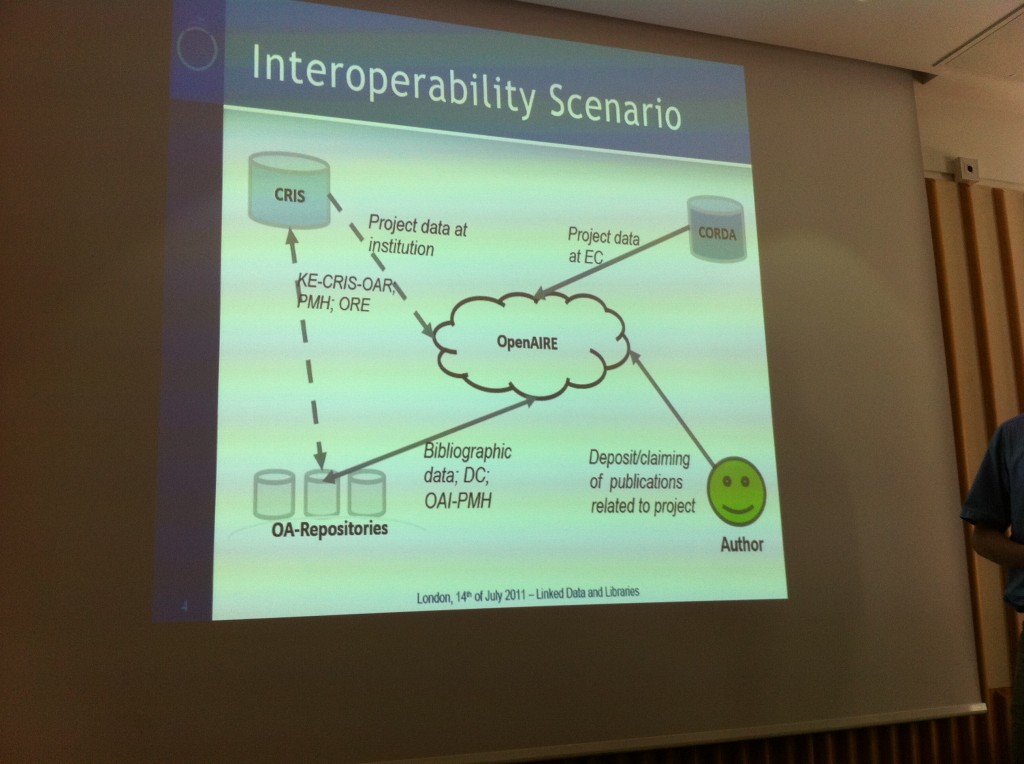Rob Styles from Talis…
First of all says – the record is not dead – it should be – it should have been dead 10 years ago, but it isn’t [comment from the floor – ‘it never well be’]
Rob says that what is missing from the record is the lack of relationships – this is the power you want to exploit.
If you think this stuff is complicated try reading the MARC Manuals and AACR2… 🙂 Linked Data is different but not complicated
MARC is really really good – but really really outdated – why a 245$$a not ‘Title’ – is it because ‘245’ universally understandable? NO! Because when computing power and space was expensive they could afford 3 characters – that’s why you end up with codes like 245 rather than ‘Title’.
If you look at the use of labels and language in linked data you’ll find that natural language often used [note that this isn’t the case for lots of the library created ontologies 🙁 ]
What is an ‘identifier’? How are they used in real life? They are links between things and information about things – think of a number in a catalogue – we don’t talk about the identifiers, we just use them when we need to get a thing, or information about the thing (e.g. Argos catalogue)
Call numbers are like URLs ….
Rob’s Law: “If you wish to link to things, use a link”
Rob pointing up the issues around the way libraries work with subject headings and ‘aboutness’. Libraries talk about ‘concepts’ rather than ‘things’ – a book is about ‘Paris’ not about ‘the concept of Paris’. Says we need to get away from the abstractness of concepts. He sees the use of SKOS as a reasonable thing to do to get stuff out there – but hopes it is a temporary work around which will get fixed.
MARC fails us by limiting the amount of data that can be recorded – only 999 fields… need approaches that allow more flexibility. And ability to extend where necessary.
FRBR – introduces another set of artificial vocabulary – this isn’t how people speak, it isn’t the language they use.
We need to model data and use vocabulary so it can connect to things that people actually talk about – as directly as we realistically can. Rob praises the BL modelling on this front.
How do you get from having a library catalogue, to having a linked data graph… Rob says 3 steps:
- training – get everyone on the team on the same page, speaking the same language
- workshop – spend a couple of days away from the day job – looking at what others are doing, identifying what you want to do, what you can do – until you have a scope of something feasible and worthwhile
- mentoring and oversight – keep team going, make sure they can ask questions, discuss etc.
Q & A:
Mike Taylor from IndexData asks – how many ‘MARC to RDF’ pipelines have been built by people in this room? Four or five in the room.
Rob says – lots of experimentation at this stage… this is good… but not sure if we will see this come together – but production level stuff is different to experimental stuff.
?? argues we shouldn’t drop ‘conceptual’ entities just because we start representing ‘real world’ things
Rob says ‘subject’ is a relationship – this is how it should be represented.
Seems to be agreement between them that conceptual sometimes useful – but that the more specific stuff is generally more useful… [I think – not sure I understood the argument completely]
